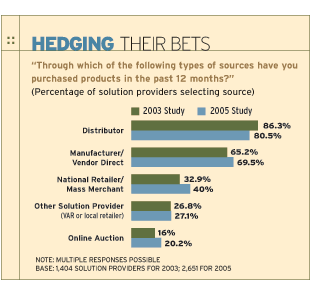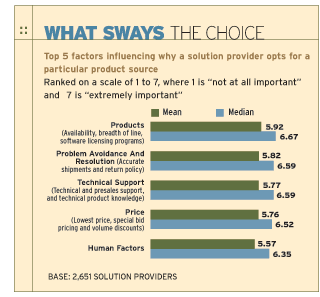Catch Of The Day
A deeper look at this year’s numbers reveals that an average of 4.61 sources are contacted for component products, 4.04 sources for peripherals, 4.00 sources for systems, 3.89 sources for storage, 3.42 sources for networking infrastructure and 3.37 sources for software.

or Joseph Connolly, the best source equals the best price.
The vice president of sales at HiQ Computers said the Boston-based solution provider will buy products for the lowest price, no matter the source. In fact, HiQ has a full-time employee dedicated to searching the Internet for the best deal.
“It depends on the item. We’ll look around, check out Pricegrabber.com. It’s all about trying to stay up with the Joneses,” Connolly said. “When we get orders placed, we get pricing up front from a vendor. We’ll go to a distributor and get their price, estimate their markup. Then once we know we’ll get the deal, we’ll push for a lower price. It’s not just like we stop and give up. We work a little harder.”

HiQ is hardly alone in its ongoing quest to find the best source for products. The CRN 2005 Sourcing Study, conducted by the CMP Channel Group with Ruzinsky Research, shows that more solution providers than ever are buying from a wider variety of sources, including two-tier specialty and broadline distributors, direct from manufacturers and via alternative sources such as CDW or eBay.
Distributors still were named as the most widely used source for products, although their influence has slipped since the last time the study was conducted in late 2003. The 2005 data revealed that 80.5 percent of the 2,651 survey respondents said they purchased products from distributors in the past 12 months, compared with 86.3 percent in 2003.
| AD | |
|---|---|
| id | unit-1659132512259 |
| type | Sponsored post |
Meanwhile, 69.5 percent bought products directly from manufacturers, up from 65.2 percent in 2003. Sales through national retailers showed the largest increase, at 40 percent from 32.9 percent two years ago. Solution providers also bought from other VARs and systems integrators (27.1 percent compared with 26.8 percent in 2003), direct marketers (27 percent compared with 25.9 percent) and through online auctions (20.2 percent compared with 16 percent).
The survey found that product breadth and availability was the most influential factor for solution providers when picking a source. But HiQ’s Connolly certainly isn’t alone in casting about for the best deal.
Price plays a large role in the minds of many solution providers, echoed Al Freeman, owner of Computron Technologies, Bronx, N.Y. He started buying desktops from CDW because he perceived distributors’ prices as too high. “We work with [CDW] to work out the shipping [charges]. We drop-ship right to the customer. It works out good,” he said.

Now Freeman buys scanners, printers and other products from alternative sources, although he still purchases the vast majority of his products from distributors, he said.
Like other solution providers that buy through multiple sources, Freeman said he would buy more from distributors if they offered lower prices. The fact is he needs the profit margins that lower prices from alternative sources can provide, he said.
“It can be a $200 to $300 difference on a [desktop]. If distributors would get more into offering solutions, I would [buy from] them, but I haven’t seen them be effective there,” Freeman said.
Distributors counter that more loyal buying behavior from solution providers would equate to better pricing and support, but solution providers say that isn’t necessarily the case. Only about half of the survey respondents described themselves as “extremely loyal” to their most preferred overall source of products.
“We’re not loyal to them, and they’re not loyal to us. We’re a small company: 10 people, $1 million [in sales]. They’re not going to show us any loyalty. Our loyalty is to our clients,” said Michael Sobel, sales and support services specialist at TS Tech Enterprises, a solution provider in Wyomissing, Pa. Sobel said his company frequently buys products from alternative sources when availability through distribution is constrained.
Price is not the only factor when determining a procurement source, but “we will not pay more than a point or a point and a half more than anybody else,” said Mike Strohl, president of Entisys Solutions, a Concord, Calif., solution provider. “The value stuff is nice, but price is one of those things we need just to keep business at the right level. That sucks for distributors, but it’s not being driven by us,” he said.
Dell indirectly plays a role in some solution providers’ purchasing decisions, Freeman said. Dell’s prices fluctuate so much that it is difficult for solution providers to know the “true” price of a PC, which leads to more price shopping as solution providers endeavor to compete against the Round Rock, Texas-based PC maker, he said.
Likewise, inconsistent PC pricing programs are the reason HiQ searches through multiple sources before buying a product, Connolly said.
“It’s the smallest things in the world—the rebates you don’t pay attention to, the cost differences between quoting somebody and when you go to pull the trigger. In a couple weeks or a month, there could be lot of things different,” he said.
In the CRN 2005 Sourcing Study, 36.4 percent of solution providers said price was “extremely important” when considering product sources, and price earned a 5.76 average score on a scale of 1 to 7, with 1 considered “not at all important” and 7 considered “extremely important.” Of the respondents, 39.2 percent cited product availability and line breadth as “extremely important.”
Ocean State Computers doesn’t hesitate to look to other sources if its primary distributors, Tech Data or D&H Distributing, are out of stock, said Robert Gregory, president of the Providence, R.I.-based solution provider. The solution provider even turns to eBay if necessary, Gregory said.
“I would call that extreme Plan B. There have been some items we needed drastically that I could find on an eBay store from a very large integrator that had exactly what we needed. They had plenty of them and sometimes for substantially less money,” Gregory said.

Turnover among sales representatives at distributors makes it difficult to foster strong long-term relationships and many sales reps do not receive adequate training, particularly around solutions, Gregory said.
Ocean State has built relationships with a couple of eBay sellers and buys directly from them without going through the bidding process, he said.
“Like a lot of other guys, when we need it, we need it. We can’t wait 48 hours or 96 hours for an [online] auction to close. Shipping [charges] are often not the best from these [eBay] guys,” he said. “The first time we used eBay, I thought we’d open up [the box] and get burned, but so far that hasn’t happened.”
A source’s ability to avoid and resolve problems was the second most important criteria for solution providers, with a 5.82 mean score on a scale of 1 to 7, and is another key issue for Ocean State, Gregory said.
“When it comes time to buy from you, I expect to be treated fairly. I won’t grind the last dime out, but if I have a problem, you better fix it. If I buy it from you, you got your price, you win. But if you fix my problem, I win,” Gregory said.
Other considerations and their average importance scores were technical support (5.77); human factors (5.57), such as technical knowledge and expertise of sales reps; logistics (5.52); configuration and integration (5.28); automated information systems (5.17); and credit (4.68).
As for shopping around, solution providers contact an average of 3.89 sources prior to purchasing products, according to the study. Solution providers contacted an average of 3.37 sources in the 2003 study.